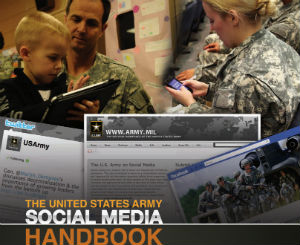|
7 Steps to SEO at Scale: How to Ramp Up Your Search Engine Optimization Strategy
 | comScore reports that in April 2013 there were over 20 billion search queries and of the 13 billion+ handled by Google, 16% of daily searches have never been seen before. Each of those attempts represents buyers looking for solutions at the moment of need. Online marketers that take advantage of modern, scalable search engine optimization best practices as part of their overall digital marketing mix can gain a significant advantage over competitors to become “the best answer” when it matters most.
Understanding the basics of search engine optimization can be challenging given how often major search engines update and change the rules. However, buyers’ overwhelming use of search to find solutions is too great to ignore its influence on the buying cycle and achieving sales growth goals.
Along with managing the implementation of current SEO best practices, marketers must also take advantage of SEO performance improvement opportunities. In competitive industries, these opportunities come up regularly and without warning. Organic search is very much a race to the top, in that one brand’s loss of positioning is another’s opportunity to move up the ranks.
Of course, ranking well for keywords that customers use when searching for solutions is useless to your business unless that positioning brings inquiries and conversions. The good news is, SEO best practices help achieve better positioning as well as the performance of those rankings. Business growth feeds the online marketing budget; brands dedicate more resources to online marketing tactics like SEO as they show growth in ROI. Marketers able to successfully manage SEO as part of the online marketing mix and demonstrate ROI can scale their SEO programs for even greater success.
But how do you do scale SEO? This post will outline 7 steps towards scaling up your search optimization strategy from benchmarks to conversions so you can create the framework for even more success with organic search.
Get Your Ducks in a Row
Planning for growth first requires an inventory of all existing assets, challenges, and opportunities. This insight helps drive a strategy based on a realistic understanding of where your business sits in the eyes of potential and existing customers – and in comparison to competitors. Some assets can be retooled, while you will realize other areas where new assets would be beneficial. Take stock of your situation and the variety of influencing factors, in order to begin planning from an informed and prepared place.
Make Your Business Case
Scalable SEO requires buy-in from company decision-makers, throughout planning and execution. You don’t need to know exactly what will happen and clearly, you don’t have a crystal ball. However, you should know enough of your business, industry, marketplace and opportunity to make educated projections based on a variety of scenarios and tactics you could employ.
A successful business case will clearly show decision-makers exactly how your proposed strategy and tactics will work and why they are necessary. Marketers need to take care to explain the opportunities (and detriment if action is not taken) in a way those outside of SEO will understand. Tie each facet of your SEO strategy to a business objective to win over those who will make or break your plans with their decisions. Most importantly, give them options. Don’t become married to one way of doing things, because there are always alternatives. Having more than one path in mind to your goal gives you the opportunity to refute rejections with alternate plans of action. It also helps decision-makers feel more involved and invested in the process when they are able to actually make decisions instead of being asked to sign off on the entire plan as a whole.
Have Resources at the Ready
If you’re handling your SEO strategy in-house, prepare training material and documentation to help new team members quickly get up to speed. Taking on new hires during growth can be challenging, as everyone involved is in learning mode.
If you are working with an agency, choose one from the start with the talent and resources to grow with your SEO needs. Remember that your SEO strategy is an investment; the cheapest option may not be the one that can scale with your growing company and its needs.
Plan a Multi-Faceted Approach
If you are responsible for the entire online marketing plan, SEO is just one of your considerations as the company grows and online marketing needs increase. If you are responsible for SEO only, you had better have a good working relationship with those who handle online advertising, public relations, social media and content marketing.
Sustainable growth requires that each component of your online marketing strategy work together. Assets from content marketing are critical to your search strategy. Social media is needed to build community, drive traffic and amplify your messaging. Email marketing can help close the leads earned through search. Integrating all aspects of your online marketing strategy brings a better ROI for each individual component and delivers a better, more personalized experience for customers.
Get Back to Basics and Best Practices
SEO changes rapidly, yet there are underlying best practices and basics that ensure your site and online presence is a good foundation for the actions you will take as your business grows. One client we worked with recently was able to increase their pageviews and conversion simply by getting back to basics, putting their customer journey first, and making on-site changes to bring them in line with SEO best practices.
Plan to Succeed and Avoid Playing Catch-up
At TopRank Online Marketing, we recently worked with a B2B online services provider looking for greater exposure of their company website in search where interested prospects were looking. They were looking to attract a very targeted subset of professionals to use their service and current SEO efforts were not effective. Though a strategic approach that included a series of SEO audits covering the content management system, content, keywords and both internal and externa links, a set of recommendations were made to optimize search visibility and performance of content in search. The result? Nearly 400% YoY increase in organic search traffic with a flat monthly investment. That’s the beauty of well planned SEO implemented over time: cost efficiency and a cumulative effect on performance.
Bringing on an online marketing agency to get their SEO strategy up to speed helped this B2B services company increase visibility where customers were looking when it mattered most. However, since the SEO strategy was not applied universally, the company did not benefit from substantial increases in search traffic for all parts of the business. By demonstrating the value of strategic SEO, TopRank was able to convince the B2B marketer to implement a cohesive optimization program based both on search engine visibility and unique content to answer prospect needs. As a result, the overall quality of traffic and the number of customers driven from search improved significantly. Imagine the results if their SEO strategy had kept pace!
Understand Your Customer Journey and Invest in CRO
If you want to be top of mind in a competitive industry, make your customers and their journey top of mind as you plan and execute your SEO strategy. Search engine optimization has to factor in what people will do, what action they will take, once they actually get to your site. CRO is the logical next step in any SEO plan, but also an important consideration in scalable SEO. Getting the right eyes on your site and helping them fulfill the need that brought them there needs to happen in tandem.
Clearly, preparation is vital to the success of an online marketing strategy that leverages SEO to better attract, engage and convert new business. We need to be able to plan, yet stay agile and able to quickly react to – or even anticipate – changing needs and opportunities based on changes within search engines and the customer dynamic.
What challenges or successes in scaling your SEO strategy to meet demand have you experienced?
|
Top 5 Social Media Questions Marketers Want Answered
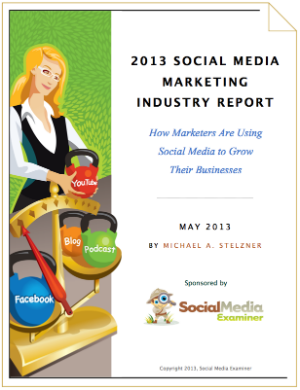 |
What if you could tap into the minds of 3,000 marketers to find out where they stand when it comes to social media marketing? How valuable would it be to know how your peers are handing the time commitments, social media platforms and measurement?
Lucky you and lucky me, the answers to those questions are found in today’s 2013 Social Media Marketing Industry Report from Michael Stelzner and Social Media Examiner.
A few of this year’s social media statistics:
- 86% of marketers say social media is important for their business
- 69% plan to increase their use of YouTube
- 58% of marketers are blogging and 62% will increase blogging in 2013
- 49% picked Facebook as the single most important social network
- 89% of marketers state that increased exposure was the most important benefit of social media marketing
From the most popular forms of social media marketing to measurement, to integration with other digital marketing tactics, this year’s report offers answers and also asks more questions.
Those additional questions “Top 5 Social Media Questions Marketers Want Answered” are the topic of this post. Below you’ll find the percentage of responses for each pressing issue and my answers plus resources for further exploration.
1. What social tactics are most effective? – 90%
Of all the questions answered by this report, identifying the most effective social media marketing tactics was the most important to respondents. Facebook, Twitter, LinkedIn, Blogging and YouTube were the top 5 platforms used by marketers in the survey.
When answering this very important and popular question, there are a few important considerations. Don’t fall for a simple list of the most popular social media platforms since what works for another company may not work for yours. At the same time, don’t think that you have to conduct an exhaustive research project into which social platforms your customers are on before making any kind of social media marketing commitment.
The practical approach is to make sure you’ve clearly identified business goals and outcomes you can measure as a result of a successful social media effort. At the same time, think about your customers’ goals and how a social presence for your brand will help make them happen. Then make sure you have a hub, whether it’s a blog or a social aggregator for your brand. Your actual tactical mix should be driven by what kind of social content and experiences will connect customers with your brand.
After a basic review of social media monitoring for brand mentions and a look at your web analytics for social referring sites, stake your claim with the top 4-5 social networks regardless if you’re B2B or B2C: Facebook, Twitter, Google+, LinkedIn and either Pinterest or YouTube. You can cross post content from your blog and curated news on the web at large to the first 5.
Once you have a rhythm for curating useful news and sharing your own content to these major networks, you can collect REAL data relevant to YOUR company and decide where to optimize your social media presence with tactics.
By starting with the networks that include a mass audience customized by your initial insights from social media monitoring, web analytics and competitive research, you can shorten the time it takes to capture interaction data that is relevant and meaningful vs. the sweeping generalizations most often made about social media marketing channels.
2. What are the best ways to engage my audience with social media? – 88%
The next most popular social question to be answered for marketers is at the core of what being social as a brand means. How to engage with your audience?
Companies that are new to the social web or that are at early stages in their level of social media maturity often know the answer to this question but simply don’t have the confidence to make commitments.
Some of the most practical things companies can do to learn the best ways to engage with their community in order to achieve mutual goals for customers and the brand include:
- Profile your customers with analytics data, social media monitoring and direct surveys. Use that insight to find out the networks they spend time on and the topics that interest them.
- Review competitors social media activities to discover anything they’re doing that appears to be working as well as things that are not.
- Research and network with influencers in your industry. And not in a desperate “please can you share my tweet or blog post?” way, but in a meaningful way that adds value, “I noticed your question about XYZ, here’s a post on XYZ best practices you might find useful”.
- Monitor your community for advocates and recognize them! Nurture and support them, but don’t try to “buy them” with freebies etc.
- Seek out questions being asked on the social web that can be answered by your company’s unique expertise. Become a known resource for those topics by answering questions without being salesy. Curate those Q&As into a FAQ in your blog or website.
- KISS – The most successful formula for successful social engagement is also the simplest: Ask your network to do things that are easy and meaningful. Then recognize them for their contributions in a meaningful way. Repeat.
3. How do I measure the return on my social media investment? – 87%
Interestingly, more marketers are interested in executing tactics than measuring what works. This disconnect speaks to the difficulty in measuring social media ROI for many companies.
The most important thing a company can do to understand their social media ROI is to clearly identify goals, understand your customers goals and how your social media strategy will connect you. Here are a few considerations:
- What is your hypothesis about the contribution social media involvement will make in providing value to customers and improving your business?
- What problems will you solve for your customers through social media?
- What is your customer’s journey in the sales cycle and where does social media fit in that experience?
- Which social media tactics will help you best attract, engage and persuade your community to become customers?
Answer those question and you’ll be able to map goals and outcomes to the social media tactics to be measured. You’ll also be able to make correlations between key performance indicator trends in social media with business outcomes. Check out “10 Questions for Social Media Measurement for Success” to dive deeper into how you can better measure your social media ROI.
4. What are the best social management tools? – 84%
One of the most popular blog posts on this site over the past 3 years is this list of 22 Social Media Marketing Management tools. Cindy King from SME has also published a great list of 24 social media marketing tools too. There are so many tools available that it’s a bit like the wild west. Big promises of automagically monitoring, managing, publishing and measuring all your social media activities sounds too good to be true because it often is.
In order for companies to scale their social media efforts, it’s essential to find the right tools to help perform social media monitoring, social content management, social engagement, social publishing/promotion and performance measurement. Tools that really do all those things can cost as much as a full time employee or more, depending on how many “seats” or use.
Deciding which social management tool is best for you requires you to do some homework. There’s no getting around it. You can start with something basic like HootSuite or Sprout Social and move up to Salesforce Social Cloud, but ultimately you’ll need to do an inventory of your needs and reconcile that list with the features of credible tools.
To shortlist potential tools, I’d recommend talking to industry peers and asking them what tools they use. This is something I plan on doing through a formal survey later in the summer.
Once you’ve identified a tool, test it and evaluate. Also understand that you’ll need to consider what the upgrade path is as your needs evolve.
5. How do I create a social strategy? – 83%
It’s not too surprising that marketers consider social media strategy long after tactics. Many companies simply don’t know the answer to “Why”, let alone “How” a social media presence will advance customer and business goals.
But knowing the “Why” is essential for guiding approach, tactics and all the mechanical blocking and tackling of daily social media engagement. This is especially true in the gray areas where guidelines are not specific. The social web is so dynamic, you couldn’t possibly account for every contingency in your social media policy. That’s why a clear strategy with brand goals and an understanding of customer goals is essential.
I’ve covered social media strategy many times here through:
Essentially, a social media strategy starts with a hypothesis about how your brand’s social media participation will connect with social networks and customers in a way that achieves mutual goals for the brand and community. What information, interaction and experience needs can you satisfy for communities that are relevant to your areas of expertise? Answer those key questions and you’ll be on your way to mapping out a solid social media strategy.
Along with sharing the 2013 Social Media Marketing Industry Report, Mike was able to do a quick interview:
[Lee] Why do you think tactics is so much higher in priority than strategies?
[Mike] Because there has been so much change in all the major social networks in the last 12 months, it really makes sense that marketers want to learn how to leverage the latest capabilities of these networks.
[Lee] The report states that 83% of marketers are struggling with all aspects of social media. Does that indicate companies are really no where near maturity with social media marketing?
[Mike] As in any emerging industry, these responses clearly show that the social media marketing industry is in constant flux. Anyone who claims to have ‘figured out’ social media marketing will quickly be outdated in a matter of months.
[Lee] How do you think marketers interest in these questions about social media will shift over the next year or two?
[Mike] Funny thing is that fundamentally marketers have been asking the same questions for the last five years based on our research. I see no reason to believe that marketers won’t continue to struggle with these questions for years to come.
Thanks Mike!
You know the old Chinese Proverb: “He who asks a question is a fool for five minutes; he who does not ask a question remains a fool forever.” What are your most pressing questions about social media marketing?
|
Integrating Digital Marketing & PR – Breaking Down Silos Through Content
 | For a recent presentation at a corporate communications and PR conference, I polled my network of digital marketing and PR pros working client-side about the most pressing questions they’re dealing with when it comes to integrating Marketing and Public Relations.
Since we’ve been working in the digital marketing and PR space at TopRank Marketing for well over 10 years, it was interesting to see the diverse feedback from companies of various sizes and industries. But several themes revealed themselves that I think our readers will relate to.
Thanks to feedback from Digital and Integrated Marketing Communications professionals like Corinne Kovalsky of Ratheon, Susan Beatty of Bremer Financial Corporation, Frank Strong of LexisNexis, Lesly Cardec from Randstad US, Sarah Skerik from PRNewswire and Pam Didner of Intel, it became clear that one of the key questions organizations are facing is the need to break down silos between marketing and PR.
To help answer that question, I think one of the most fundamental things to realize is that we’re all in the content business.
PR and Communications drive a substantial amount of content creation from developing messaging strategy to content for newsrooms. PR content that can be optimized, socialized and publicized include: blog posts, press releases, case studies, social media content, newsletters, contributed articles, white papers, events (online and off). Whether it’s text, image, audio or video, most PR pros are involved in content creation on a regular basis.
Content is the currency for building social relationships that can boost earned media.
Digital Marketing is tasked with demand creation and developing leads, and content plays an instrumental role in those and many other marketing objectives. From content marketing strategy to websites and microsites, content is the basis for effective digital marketing. We’ve covered content marketing tactics here before, but they can include blogs, landing pages, social media content, advertising, webinars, email and all media formats from images to video to audio.
Understanding the role that content plays in reaching both brand awareness and customer acquisition goals, the opportunities for integration between digital marketing and PR become clear pretty fast.
Align Goals
When you look at common Public Relations focused goals, they often include: Boosting Awareness & Exposure, Influence & Positioning, Increase Mindshare, Educate Audiences, Thought Leadership, Reputation, Growing Networks & Engagement and even Increasing Sales.
Often these goals are achieved through a variety of efforts that leverage or result in content. Digital PR tactics can range from media relations to gain editorial coverage in publications to events to working with influencers and social networks. Announcements, publicity, promotions and buzz are all the domain for PR and communications professionals.
Some of the metrics digital marketers are held accountable to include increasing website traffic, leads and sales. Content Marketing goals also include revenue related objectives like order volume, frequency and profitability. Efficiency is also aligned with content marketing performance as measured by shortened sales cycles, referrals bottom line ROI on marketing investment.
Since both marketing and PR both speak “increase sales”, it make sense that PR should be involved with content marketing in its planning stages to identify what’s “really” promotable from a media relations perspective. Building publicity and media relations activities into the content marketing planning process will help marketing extend the reach of it’s message and improve marketing performance.
At the same time PR will have early exposure to promotable brand content to successfully achieve media coverage and network growth vs. trying to make magic happen with last minute requests: “Can you send out a press release and talk to some bloggers about our new product future? It was released this morning”. For both marketing and PR, there can be a measurable effect on sales and we all know revenue is the language everyone understands.
Common Ground:
An extension of aligning goals between marketing and PR is to find the win for those that you would partner with in your organization. Find out how can marketing assets be used to improve the ability for PR to gain media coverage. At the same time, dig into how PR can play a role in content marketing amplification to improve the reach and performance. Recruit volunteers to test cooperative efforts between digital marketing and PR.
Some of the common ground opportunities for digital marketing and public relations include:
- Messaging & Story
- Content Planning
- Coordinated Social and Media Relations with Amplification
- Social Listening for Buying Signals
- Content Placement
- Optimizing Messaging Based on Marketing Performance Data
Coordinating marketing and PR in content marketing efforts can find the common ground needed to execute on shared goals. That alignment of objectives can lead to the development of new ways of working together that create a win for everyone involved.
Build a Business Case
Goal alignment and common ground serve as a framework for building a business case. Find a low hanging fruit opportunity with motivated collaborators to show how digital marketing and PR integration can improve achievement of business goals. Then sell the results with performance metrics that execs can appreciate.
One of the most basic examples of this kind of collaboration is a co-created thought leader ebook. We’ve created quite a few of these and they represent the integration of key maketing and PR in a way that is pretty easy to demonstrate value for both awareness and network growth as well as traffic and sales.
Co-created content builds an incentive for participants to promote the content object. Publicity, content repurposing, targeted ads, email promotions, social promotion and optimization combine with thoughtful messaging to create an integrated marketing and PR asset that provides a tremendous amount of value for PR and marketing goals.
In the digital marketing world, skills acquisition is as competitive as it has ever been with PR high on the list. With more brands publishing content and even competing with publications in their industry, the need for integrated marketing and PR functions within companies is a necessity. The question is, what is your company, large or small, doing about it?
If you would like to learn more about integrating marketing and PR, be sure sign up for the PRSA Digital Impact conference in June where I’ll be presenting ”Attract, Engage and Convert: How PR Can Get Ahead With Content Marketing“. This topic is also covered at both a strategic and tactical level in Optimize as well.
Image: Shutterstock
|
Online Marketing News: Video Trends Map, Content Recommendation Engine & New Google+ Layout
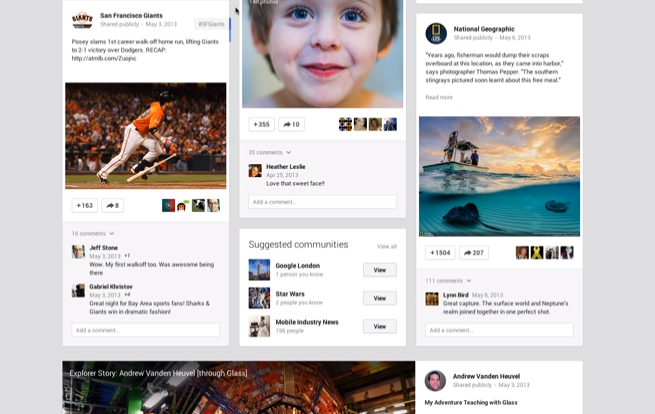 |
New Google+ Layout: Hangouts, Photos and Stream Reminiscent of Pinterest
Google announced a major update to their social network this week that changes the way Hangouts, photos and the Google+ stream are viewed by users. The decidedly Pinterest-esque layout was just one of many announcements this week out of Google I/O, the totality of which Jeremiah Owyang and Chris Silva dubbed a “wreck.”
“The end result, we hope, is an app that looks and feels great across a family of devices,” Senior VP Vic Gundotra wrote of the Google+ changes. This is in line with Google’s mantra of late: Technology works best when it gets out of the way, and lets people do what makes them happiest: living, learning and loving.
With the announcements of more interconnection of services, Google Maps as a virtual world, Google All Access music streaming and more, Owyang and Silva remind consumers to expect the tools and products to get better, but to know you're the product. If brands want to play in Google's sandbox, they'll ultimately need to pay, they said in summary.
Visit Web-Strategist.com to see the rest of Owyang and Silva’s commentary on what they called a “patchwork set of announcements from a fragmented company,” live from Google I/O.
Online Marketing News Briefs
It’s no surprise much of this week’s news pertains to Google and their products, given their I/O event and a myriad of changes announced this week. However, Facebook also made headlines through their retail social/mobile partnership with Target, as did insightful reports for online marketers from Google and GlobalWebIndex.
Content Recommendation Engine for Mobile Sites Launched by Google
Google has rolled out a content recommendation engine, which makes content recommendations for users at the bottom of the screen on news sites with the service enabled. Sites need just one snippet of code to add this functionality to their site. See more at TechCrunch.
Over Half of Global Internet Users Signed In to Facebook in Q1 2013
Facebook continues to dominate as the most popular social network on the planet, with just over half the world’s online population logging in on the site in the first quarter of 2013. Google+ came in a distant second, with 26% of global internet users, followed by YouTube, Twitter and Sina Weibo. See further analysis of GlobalWebIndex’s report at eMarketer.com.
Target and Facebook Join Forces in Cartwheel Mobile/Social/Retail Partnership
Cartwheel, a new site from a Target/Facebook partnership, has launched in beta and will begin rolling out their mobile/social program for retailers to a select group of participants shortly. The program allows users to browse exclusive deals and sales, with additional savings for social sharing. Learn more about Cartwheel at MediaPost.
Google+ Launches Auto-Hashtagging
As part of the Google+ design makeover, a new feature enables automatic hashtagging in posts. Google will use data from their social graph and analysis to identify hashtagging opportunities and add them to content. Users can remove hashtags they feel are inappropriate. Read more about this new feature at Fast Company.
Mobile Search an Influencing Factor for 84% of In-Store Shoppers with Smartphones
The majority of consumers shopping in-store are using smartphones to help them make purchasing decisions, according to new research from Google. Of those, the vast majority – 82% – are using mobile search, rather than apps or direct navigation to company websites – to access shopping information. Search Engine Watch has additional insights from Google’s Mobile In-Store Research: How in-store shoppers are using mobile devices report.
New YouTube Trends Map Shows Viral Videos Across the US
People in search of a visual way to see which videos are trending across the United States have a new tool, courtesy of YouTube. The YouTube Trends map displays the most popular videos across the country, with the option to drill down by gender, age, location and type of activity on the video.
This Week in the @TopRank Community
Our community – whether at Online Marketing Blog, on Twitter or elsewhere on the web – is a group of insightful, generous marketers always willing to share their experience with other members!
Check out these great tips, comments and quirky news from the @TopRank community this week:
It is very true that we need to be SHOWN how things work. It always makes me laugh when people tell me “I’m a visual person”, as if having a drawing in front of them is the only way they would see it. What they don’t realise is that EVERYONE is a visual person. On the other hand, if you were truly ‘visual’ you wouldn’t need it shown to you – you could see it in your head anyway. That’s what visual creatives do.”
~ from Suffolk Graphic Designer in response to The Power of Visual Content Marketing and Brand Visuals in Action on how your audience learns through content.
Stay tuned to the @TopRank Twitter channel this week for the latest online marketing, social and content headlines!
|
11 Examples of Killer B2B Content Marketing Campaigns Including ROI
 | According to a CMI and MarketingProfs study, 91% of B2B Marketers are using content marketing and that means a few things:
First, it means content marketing has gained critical mass within the popular marketing mix and any company in a competitive industry would be hard pressed to attract business without it.
Second, it means competition to stand out with your brand’s content is only going to get harder as more companies adopt content marketing best practices and mature in their skills.
As companies evolve from simply recognizing the important role of content and experimenting with it, to achieving content creation competency and quality, the need to optimize content marketing skills becomes increasingly important. But where can B2B marketers find new ideas and expand their opportunities to grow content marketing capabilities?
The good news is that B2B Marketing innovation is alive and well and can be found in many places. One place I like to look is case studies and awards for successful B2B marketing work.
A few weeks ago I presented at DemandGen Report’s B2B Content2Conversion conference along with tier one B2B marketers like Michael Brenner from SAP, Jill Rowley from Oracle / Eloqua, Ann Handley of MarketingProfs, Joe Pulizzi from Content Marketing Institute and many others.
On top of hearing strategy and practical tactics from speakers, there was a Killer Content Marketing Awards presentation that highlighted some incredible creative, execution and most of all, performance of B2B content marketing programs.
Highlights included:
SunGard – Created awareness amongst IT professionals for SunGard Cloud offerings with a zombie themed campaign. The zombie themed effort resulted in exceeding download rates by 300%, a 5.7% email open rate and 20+ leads.
Limelight Networks – Implemented a “For Dummies” themed education campaign drawing attention to success and failures for companies and their digital presence. The campaign gained exposure through nearly 10,000 social media and news release views and $200k+ worth of sales opportunities.
Logicalis - Using content assets such as emails, microsite and ebook, Logicalis developed a thought leadership effort that supported sales teams by enabling custom messaging based on the prospects interaction with the campaign. With a target audience of about 2,000, nearly $8 million in new pipeline business was closed.
Sales Benchmark Index – Targeting prospects that were newly hired VPs of Sales, this campaign focused on providing a toolkit that identified corporate pains when VPs of Sales fail as well as case studies of successes. The promoted ebook was downloaded by target VPs 5,781 times.
Lattice Engines – Partnered with a research firm to create a study showing the impact big data has on sales. A robust mix of content marketing tactics were used to promote the report including: ebook, blog posts, guest articles, video interviews, Slideshare and an infographic. The report was downloaded 500 times, covered by 15 blogs and industry media sites and 1,500 views of the ebook.
Optum – Created an integrated marketing campaign to support the launch of a new solution, support sales and build thought leadership. The content marketing mix included: advertorials, display ads, email, direct mail and a campaign website. The successful campaign earned a 23.5 lead to conversion rate, 475% increase in website traffic, 2,500+ resource downloads, 28% increase in YoY blog followers and $52 million in contract value of new business with less than $ 1million invested.
ADP – Developed a content marketing campaign to connect and engage with their target audience on a ADP solution using white papers and a diagnostic assessment tool. The campaign generated over $1 million in new sales opportunities with several deals closed within the first 3 months of launch.
Demandbase – This education campaign was designed to help B2B marketers make the right content technology investment by using a white paper, infographic, webinar, Slideshare and a live presentation to spotlight tools that can maximize the power of content. The results of the campaign included 1,700 leads, 125 webinar participants, 5,000 views on Slideshare and $1 million in new business.
Xerox – Created a targeted “Get Optimistic” campaign to connect with 30 top accounts and partnered with Forbes to create a magazine that offered relevant business tips. 70% of targeted companies interacted with the microsite, readership increased 300-400% over previous email campaigns, added 20,000 new contacts, generated 1,000+ scheduled appointments, and get this: yielded $1.3 BILLION in pipeline revenue. Yes, BILLION.
OpenText – Created a personalized new customer onboarding site offering a variety of assets (white papers, checklists, product pages, ebooks, case studies) and content to welcome new clients and provide upsell, cross-sell opportunities. The campaign also included a two phase nurturing program. 1,700 new contacts were identified along with 31 new opportunities worth $1.8 million.
Crowe Horwath – Using 48 pieces of content in 4 different topic areas, this campaign targeted C-level prospects in financial institutions with $1 billion or more in assets across the buying cycle. Content tactics included: executive briefs, case studies, infographics, checklists, Q and A, and Brainshark video. 778 contacts were engaged with a 70% open rate (vs. 10%), 2 engagement worth $250k in revenue.
One of the interesting things about these B2B content marketing campaigns is a fairly consistent LACK of attention to optimizing content assets (images & infographics, video, PDFs, etc) for search. Many of these campaign assets could continue to attract new prospects or at least attract more than they are if the assets were more visibile for relevant keywords. Just using the titles of the files and documents was difficult to find many of these. Many of these content assets are near invisible when it comes to buyer-centric keywords.
Just remember marketers, when it comes to content, there’s no excuse not to socialize, advertise, publicize AND optimize. This approach represents a lot of what we do at TopRank Marketing.
Here’s the full deck for details on each Killer Content Marketing campaign plus performance data. Enjoy!
What are some of your favorite killer B2B content marketing campaigns? Which B2B brands are doing it right?
|
The Power of Visual Content Marketing and Brand Visuals in Action
 | Visual content is certainly trendy – see the meteoric rise in infographics and social engagement with images as proof. Yet the need for content that appeals on a visual level and presents information in a more engaging format than text goes far beyond what is cool or fun to create.
In creating curriculum and learning materials for students (child to adult) and their teachers, I learned just how important visuals are in meeting the needs of different types of learners. This is too often a missing piece in the marketing mindset; we focus on what we want people to do, the action we want them to take. We think of learning styles in terms of learning disabilities, yet the ways in which every person on the planet takes in information should be a major concern for marketers, whose express purpose is to get people to take in information.
Through your content, you may be inspiring, engaging, entertaining. What you are doing though, at the basic level, is teaching. You want your audience to understand the information you are sharing. You want to influence their decisions. Empowered consumers seek out information to help them make the best decision, often considering multiple sources.
Now pair this customer insight with what we know about how people learn: the majority of people are visual learners, either primarily or in combination with other styles. You’ll see a range of stats on the percentage of learners in each group, though 30% visual, 25% auditory, 15% kinesthetic and 30% mixed learning styles is a commonly accepted figure. These are the three major learning styles and though one person may use a combination of styles to take in information, we all lean towards one primary preference.
Kinesthetic learners best retain information they discover through touching, feeling and experiencing material. You might think there is no real “touch” in digital information, yet this is where interactive games and touchscreens are an important tool.
Auditory learners consume and retain information best by listening, often through repetitive information. Podcasting is a good way to connect with auditory learners.
Visual learners, the largest portion, want you to “Show me so I can understand.” You might accomplish this through charts, infographics, video demonstrations, comics, visual e-books, photos, or even animation… the point is, you are acknowledging this unique learning style and tailoring information for best consumption and comprehension.
We saw a fantastic example of a visual learning style recently at Social Media Marketing World, when an attendee shared her visual notes from Lee Odden’s presentation on blogging for business. Taking in auditory and visual information, this person sketched notes rather than writing them, in order to more easily recall the information she wanted to retain later on. It resonated with the social community because others learn this way, as well.
This understanding of how people learn, consume information and are influenced by it lies at the heart of everything we do as online marketers: user experience, content creation, web design, social media marketing and even search engine optimization. We know visuals are important for engagement and social sharing, but understanding the “why” will help you create and optimize content that is truly in tune with your audience preferences.
Now that we know the “why,” check out these examples of companies getting it right with visual content that inspires, engages and most importantly, presents information in a way prospects can understand and retain.
General Electric – Show Me How It Works
General Electric houses their images on Instagram (above) and Pinterest, though they use these same images in blog posts and across their social channels. Their Instagram images, in particular, focus heavily on showing their B2B audience how their products work in real life. Who wants to see a piece of a machine? Show me how it works! They do, and the result is that prospects can picture GE products in action for their own company.
Kellogg’s Pop Tarts – Show Me a Story
The Pop Tarts Facebook Page showcases their masterful visual storytelling skills. Their brand marketers use comics, cartoon characters, and simple images to present information in a fun and engaging way. Their strategy is to entertain, to keep their audience engaged and their brand top of mind. These quirky images are perfect for social sharing and tell stories through single images, or image series released over a period of hours or days. They even have recurring characters who pop up now and again, breeding familiarity and creating anticipation. It’s a winning visual content formula for a B2C brand in a competitive market, where every touchpoint counts.
Rubbermaid – Show Me Why I Need It
Look in your own closet. Now look at Rubbermaid’s closet organization images on Pinterest. Back to your own messy closet. Now back to Pinterest. Rubbermaid shows consumers precisely why they need their product with attractive, high quality photos shares to the social networks their audience members frequent. My closet looks nothing like this. I need Rubbermaid.
Callaway Golf – Show Me How to Use It
Golf brand Callaway has their YouTube channel organized into different types of videos, including instructional clips for golfers. They create videos in series, such as Office Golf Tips and Bones at Work, to create consistency and build anticipation for coming videos. Celebrities like Phil Mickelson appear in their instructional videos to show golfers how to improve their game… using Callaway clubs, of course. Teaching a golf swing absolutely requires video; you would have a hard time learning from written instructions. Callaway just does theirs better than most and have become a reliable resource and authority for golfers, as a result.
Show Me
As you plan your visual content, think hard on the “why.” It’s not about what you want to tell people. What do they want you to show them, to help them make an informed decision and stay connected with your brand? You absolutely must understand what your audience needs you to show them in order to engage and convert, especially when they are bombarded with imagery on a daily basis. This insight and customer-centric perspective will help drive your visual content strategy and you will never run out of creative stories to tell with compelling content.
What factors do you consider when planning and creating visual content in your organization? Share your thoughts in the comments!
Image at top from Shutterstock.
|
Content Marketing Tactics: Business Blogging Pros, Cons, Best Practices & Brands Doing It Right
 | As part of our continuing series on content marketing tactics, I’ll be covering a topic that is absolutely near and dear to every content marketer’s heart: business blogging.
According to a recent NM Incite report, there are over 181 million blogs around the world. The way many companies treat blogs in their content marketing mix is to incorporate blogs into their website as a section or subdomain, or host them on their own domain name as we do.
With that kind of popularity, you would think everyone in business would know what a blog is and would be using them to their maximum advantage. Trust me, I’m in the content business and they don’t. In fact, brands split just 11% of their total social media budget between blogging and influencer outreach. So just to clear up any ambiguity and to follow the format for this series, here goes:
Definition of Blogging: Blogging is a form of content publishing leveraging a content management system such as Blogger, Typepad or WordPress that often publishes articles, video, images or audio in reverse chronological form.
Business or corporate blogs are social media and content marketing tools used by companies to provide valuable, interesting content for customers, employees, industry media and other target audiences. Ideally, blog content fulfills a potential or existing customer’s need for information at some point in the purchasing cycle, in order to assist them in making a buying decision.
How Are Blogs Used for Business? Content Marketing Applications:
Internationally, countless companies are using blogs to attract, engage and convert their target audience, though a select few stand out as masters in the corporate blogging trade. Whole Foods Market, for example, has an exceptional corporate blog called Whole Story, through which the grocery brand shares healthy eating tips, recipes, and more. Their focus on providing helpful, non-sales driven information to readers keeps them top of mind as a resource, rather than an advertiser, in the eyes of their fans.
comScore’s blog is an excellent example of a B2B blog that has catapulted them into a mainstream news source, helping to build brand awareness and authority. Their top quality research and information has also helped their authors, like Eli Goodman and Andrew Lipsman, build their own personal brands, as well.
Business blogs are a form of social media in their own right, though they work best as part of an online marketing strategy that uses other social channels for amplification and community building. Blog content should also be optimized for maximum visibility in search.
Business Blogging Pros & Cons:
As with any content marketing tactic, there are advantages and challenges to blogging:
Pros -
- Excellent tool for brand awareness, authority building, storytelling and passive sales messaging.
- Low barrier to entry with no technical or IT skills required to contribute content.
- Ability to measure and track performance.
- Flexible platforms with multimedia capabilities to distribute information in a variety of formats.
- SEO benefits; enhanced visibility in front of people seeking a specific type of information.
- Attract new customers, engage existing ones and convert both to buy – more and more often.
Cons -
- Can be time consuming to create content.
- Requires a publisher mindset from brands possibly not used to this model.
- Requires planning, organization and editorial control, particularly with multiple authors.
- Creative, unique content can be a challenge.
Expert Opinions on Business Blogging:
Blogging as part of an integrated online marketing and content marketing strategy is practiced and endorsed by top marketers from agencies and brands alike.
"A blog is only as interesting as the interest shown in others." ~ @LeeOdden, CEO, TopRank Online Marketing ( blog)
"Be helpful, give away everything you can, and make sure you put posts together that people feel they can relate to and that have something to add to." ~ @ChrisBrogan, President, Human Business Works ( blog)
"Traditional marketing talks at people. Content marketing talks with them." – @DougKessler, Velocity Partners ( blog)
"Even when you are marketing to your entire audience or customer base, you are still simply speaking to a single human at any given time. Worry less about sounding professional and worry more about creating remarkable content that other humans can relate to." ~ Ann Handley, Chief Content Officer at @MarketingProfs ( blog)
Related Blogging Software and Resources:
Recently, I shared 11 of my favorite blog and social content creation tools, including an editorial calendar, Twitter lists and Ubersuggest. Lee Odden has written extensively on blogging for business, including optimizing and socializing blog content, marketing your blog, integrating blogs with content marketing to inspire action and much, much more.
Download a sample editorial plan and keyword glossary to help you organize your blogging efforts and align them with your business goals. These are available free at OptimizeBook.com.
Check out the content marketing courses at MarketingProfs University to help you improve your blogging, presentation and social skills. Be sure to check out Marketing Writing Bootcamp and Content Marketing Crash Course, in particular.
Since we’ve been practicing what we preach about bloggin for over 9 years, there are numerous articles on blogging here at Online Marketing Blog. The content marketing and blogging landscape has certainly changed over the past decade, yet best practices and the importance of blogging in alignment with business goals have remained largely the same. Smart businesses are getting social and using blogs as one of the powerful weapons in their online marketing arsenal to attract, engage and convert their target audience to loyal customers.
What are some of your pressing blogging questions or best practices tips?
Image from Shutterstock.com.
|
Want to Improve Your Online Marketing? Master These Search & Social Media Tactics
 | Fast changing trends and serious competition has digital marketers chasing the latest and greatest tactics like hamsters on exercise wheels.
Good advice is both hard and too easy to come by. Search “social media marketing” on Google and there are over 1 billion results.
All the scrambling often means core skills are overlooked. In fact, one of the easiest things a company can do to improve online marketing performance is to stop sucking at the basics.
When it comes to optimizing for search and social media, well implemented basics are as good for search engines and social networks as they are for your customer’s user experience.
Here are a 8 fundamentals worth applying to your organization’s daily content creation, amplification and optimization process.
1. Be the Best Answer: Start by answering a few questions of your own:
- What does your brand want to be known for?
- Is that thing what your customers really care about?
- Do you deserve to be known for that thing?
Look at leaders and authorities for the topics that matter most to your business and observe the deep and meaningful resources they provide. Tap into what makes others so authoritative and incorporate those characteristics in your own marketing. Start the journey to become the first choice amongst your customers for those topics that matter most.
2. Win Friends & Influence People: People are social and so too, should your online and search marketing. Some social networks are better than others as stand alone communities for brands, but make no mistake, social signals matter for people and search engines. That means creating, engaging and promoting brand content on social networks to inspire shares and links from people with authority on topics you want to be known for.
Use social search and influence scoring tools like Traackr, Kred, Klout, Little Bird and FollowerWonk to triangulate where the influencers are, topics that matter and incorporate that insight into your content, PR, social and optimization.
3. It’s Not About You, Or Me Or Us. And Definitely Not Them: With content for the web or social, avoid overuse of personal pronouns like "I," "you," "she," "he," "it," "we," "you," "they" and objective pronouns "me," "you," "her," "him," "it," "us," "you," and "them". Instead, use more descriptive keyword phrases where social sharing widgets will copy your message and where Google is looking in page titles, file names, text links between pages, image alt text and in body copy.
Keyword use is also a fundamental that should not be overlooked. But remember, the priority is on optimizing for people and the experience they have with your content. Copy should flow smoothly and not read like it’s unnaturally using keywords. Find out what phrases your competitors are using to attract search traffic by using SEMRush, SpyFu or Keyword Spy.
4. Facts Tell, Stories Sell: Figure out why customers buy and create keyword optimized content that tells stories about how and why your products solve customer problems.
Talk to sales staff and ask them about how they are so successful and about the discussions they have with customers. Those stories are a goldmine of ideas for great content that matters to people who want to buy your products and services. Content sourcing and ideation can be challenging, but tapping into the Q and A around topics that matter during the sales cycle reveal a never ending source of meaningful ideas.
5. Optimize for Search & Share: While a lot of optimization emphasis is placed on creating web pages and media (images, video, audio) around topics and even specific keywords that customers are actually searching for, it’s also important to make social sharing compelling and easy.
To do that, start mastering the art of title writing to catch people’s attention but also include search phrases. Example, “10 Essential [keyword phrase] Tips & How to Boost [keyword phrase] Performance.
Also be sure to include social sharing widgets in your content and experiment with the best formats and networks for your audience. Most of optimization is simply about making it easy for people to do what you want them to do. Finding and sharing your content is certainly near the top of the list.
6. Links Are Like Electricity: Light up useful content on your website by sharing with topically relevant social networks, through blogging and byline articles in industry publications. Find out where your competitors are getting their links by using tools like Majestic SEO, AHerfs or Open Site Explorer.
Do not underestimate the power of media relations and PR for getting into industry publications that also result in links. Whether through feature articles or guest blog posts, contributing content or insight to respected publications that also include a link to your brand’s social or web assets helps brand credibility, sends traffic and influences search visibility.
7. Tune Up Your Engine for Search Engines: Have your website audited by a SEO professional to ensure keyword targeting in content, technical friendliness to Google and Bing, inbound links and social shares. Pages that load fast for people and search engines is good user experience and good SEO.Web Developers and content management systems can be your worst enemy if left unoptimized for search.
8. Live the ABO: Always be Optimizing: Optimization is a continuous process of creating and promoting keyword optimized content on social networks, through industry media and online communities, then monitoring performance through analytics and making refinements.
Be sure to allocate resources for monitoring social networks (Trackur, SproutSocial, or Sysomos among many others), tracking and evaluating web analytics and applying conversion rate optimization best practices to ensure your findable and sharable content is influencing action.
The blocking and tackling of online marketing may not be the most glamorous, by why leave so much marketing opportunity on the table with skills and tactics we all claim to be so good at? Optimized marketing requires a solid foundation and if your organization is having difficulty scaling performance, then maybe it’s time to take a look at the fundamentals.
I think Optimize is a book that covers these fundamentals pretty well, so be sure to check it out.
What are some of the online marketing basics that you see often overlooked?
|
Online Marketing News: RipOff Report Expands, Paid YouTube Channels Launch & Mobile Local on the Rise
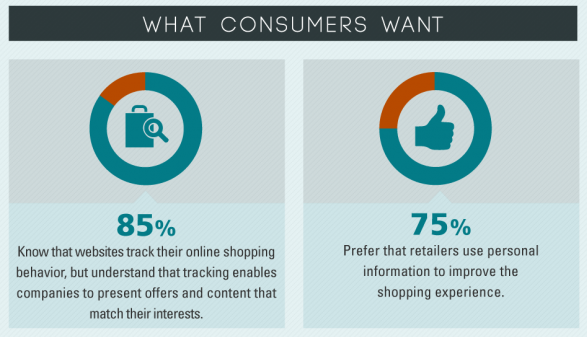 | Your customers want more personalized messaging and content. In fact, 64% believe it’s more important that companies represent them with relevant offers, compared to 36% who don’t want their activity tracked. Given the tools available to block ads, tactics to stop tracking, opt-in nature of communications and social participation, it’s clear that customers who do choose to interact with brands expect a more personalized experience as a result.
The Mass Marketing vs. Personalization infographic from Monetate shares a number of other interesting recommendations and finds, including:
- 94% of companies agree that online personalization is critical to business performance.
- Two of every three companies believe personalizing their website will improve the customer experience and overall success of their business.
- 64% of companies will – or plan to within the year – deliver a more personalized experience to visitors on mobile devices.
See the infographic for tips on better personalization.
Online Marketing News Briefs
Mobile Increasingly Used for Local Search
More people are using mobile for search, especially for local information, according to a new Local Mobile Search Report based on comScore data from Q4 2012. PC traffic has remained static, researchers said, while mobile continues to grow as a percentage of overall traffic to websites. See more at SearchEngineLand.
Klout Aims to Let Consumer Be More Influential with “Experts”
Klout previewed their new “Experts” feature Wednesday. AllThingsD.com explains how it works: “If you've garnered sufficient credibility on a certain topic based on your Klout score — say, gardening or hair styling or whatever — you should be qualified to answer questions on the area. Moreover, you're likely more credible than some result in a Q&A thread on a site like Yahoo Answers or perhaps a Quora.” Klout shared questions to some of its users, whose answers will show up in Bing search results (Klout's official search partner) and possibly Google.
Mobile Shoppers Spend More in Store: Google
Seventy-nine percent of smartphone owners are also smartphone shoppers and 84% of them use their devices in-store to help them make buying decisions, according to Google’s Mobile In-Store Research report. On average, smartphone shoppers spend 15 minutes on their device while shopping in-store.
Affluent Consumers are Active in Social Media: LinkedIn
Of the 90% of consumers with investable assets between $100,000 and $1 million active in social media, 44% engage with financial institutions via social. According to LinkedIn, 36% of this group use social for discovery and consideration. See more at SearchEngineWatch.
RipOff Report Expanding: Businesses Can Opt In to Pay $90/Month Fee to Review Complaints
Not that companies should be pleased, but Ed Magedson of RipOff Report has devised another way to help companies on the receiving end of customer complaints (real, imagined or invented) part with their money. His new RipOff Report Verified program will give businesses 14 days to resolve complaints before a critical review is posted. See more at Forbes.
Sesame Street and Young Turks Among First Paid YouTube Channels
The first paid YouTube channels launched yesterday, with 30 YouTube partners making the move to a revenue model alternative to advertising. The initiative will become self-serve for YouTube’s 1 million+ content partners, who will be able to charge a fee starting at 99 cents a month for access, according to AdAge.
This Week in the @TopRank Community
This week, TopRank CEO Lee Odden gave the keynote presentation at #PDXCC13 just a day after sharing An Integrated Approach to Digital Marketing & PR with Public Relations Society of America members and webinar guests. Check out our favorite tweets and interactions from members of the @toprank community:
Stay tuned to the @TopRank Twitter channel and #trnews feed this week for the latest online marketing, social and content headlines!
|
Tips for Brand Social Media Marketing Success with Agencies & Consultants
 | Planning and executing a successful social media marketing strategy sometimes requires that brands look outside their own companies for assistance. Businesses may partner with consultants or agencies to tap into the expertise, skills and resources they can offer, to help with strategy and tactical execution of the plan.
However, things can go wrong in social and when they do, the fallout can be massive and instantaneous. I wrote about a few examples of epic social fails recently and sometimes, brands find themselves having to defend their image over the damaging actions of an external resource. Tsk, tsk, people say. They should have handled their social media in-house and this never would have happened. This was certainly the case with Celeb Boutique, who publicly laid the blame for their insensitive #Aurora tweet at the feet of their PR agency.
Not so fast, though. Social media fails originate in-house and from external partners alike. Internal processes and failures can cripple your social strategy as surely as external resources.
Working with an agency, consultant or other resource can help your brand execute a successful social media strategy while still reducing the risk of a slip up. In fact, a solid resource will help you scale your social efforts, tap into new markets, perfect your messaging and take your social strategy places you hadn’t even expected. Sounds good, doesn’t it? Before I jump into tips to ensure your agency or consultant relationship works to your maximum benefit, let’s look at a couple of reasons social may fail when working with an external partner:
- Slow response times. Social fans – especially those on Twitter and Facebook – expect a quick response, especially when they’re voicing a complaint. In fact, 42% expect a brand response in 60 minutes or less. The need for approval of messaging can slow down response times substantially and hamper conversation.
- Inaccurate or uninformed responses to questions/comments. The people creating your social content need to know your business and understand your audience inside and out.
- Inconsistent or infrequent community management. If your content is being broadcast but interactions are not monitored often, you’re missing a huge opportunity to connect and may be doing more to harm relationships than build them.
- Inappropriate messaging. This may range from irrelevant to entirely inappropriate, but if the message is off, your company isn’t being well represented on the social stage.
- Lack of consistency in situation management, brand voice or content. Regardless of who is involved in your social strategy, to your customers, your online presence should be unified and consistent.
Understanding your own social pain points and where things may break down across your social strategy enables you to plan accordingly. The first step is finding an external resource with the skills, experience and knowledge to help you elevate your company’s social presence. With PR agencies, SEOs, social specialists, digital marketers and more, what are you looking for in an agency?
Ask the following questions (at the very minimum) to help discern whether the agency is a good fit for your social needs:
- How will you collaborate with our internal team (and any other external resources) to make sure our efforts are coordinated across SEO, print, paid search and other marketing/advertising activities?
- Do you understand our business goals and what tools/processes will you use to help us achieve them?
- Can you share examples of successful social campaigns you’ve managed for other clients?
- How will we communicate throughout the relationship and which types of situations will be brought to our attention immediately?
- Which members of your team will be involved in each facet of our social strategy?
That’s an incredibly basic overview, but you need to make sure the external partner understands what makes your business unique and that they will be able to convey that through social media, in tandem with your other marketing efforts. Once you’ve chosen an agency:
Establish their role… and yours.
How will information flow between the agency and your company? It is critical to understand how this will work for both parties. Weekly meetings and reporting are great, but what happens when a customer needs an answer to a question after hours? How should the agency ask for information they need to complete content and social amplification tasks in a way that best enables you to respond quickly with what they need? Is the agency expected to provide customer service, or should they refer certain types of inquiries in-house?
Brands and agencies work together in different ways; your agreement may have them acting in a consultative role only. Or, they may assist in content creation, amplification and measurement. They may even handle your entire social strategy, start to finish. Establish who is responsible for which area to prevent misunderstandings or lost opportunities.
Tips for Working with a Social Media Marketing Agency:
You’ve hired an agency, you’ve established roles and you have a social content plan in place that aligns with your business goals. Now, make the most of your agency relationship by:
- Setting clear goals and expectations.
- Getting any budget concerns out of the way. Deliverables, timeline, responsibilities and obligations must be clear to prevent issues down the road.
- Being available when they have questions or need information.
- Providing training as to your brand voice, core messaging, and existing resources.
- Keeping your agency in the loop as products or services change, other types of campaigns launch, etc. They can’t answer questions or hold your brand’s end of an intelligent social conversation if they don’t know what’s happening inside the company.
- Being open to change driven by logic and substantiated by research. This may mean increasing/decreasing a social ad budget, focusing more resources on one social network than another, or any other of the myriad of situations that can crop up in the constantly evolving social space.
- Establishing a social protocol that establishes messages your external partner can share and which situations require in-house approval or involvement before proceeding.
- Staying involved throughout the working relationship. Would you give someone your television budget and let them run with it? Social media is incredibly public and you absolutely need to stay involved in how your brand’s presence is managed.
Careful planning and diligent management are key to the success of your social media marketing efforts when partnering with an agency or consultant. Can you think of other tips to help brands work more effectively with external resources? Please share yours in the comments!
|
Keynote Presentation: Digital Convergence of Public Relations & Marketing
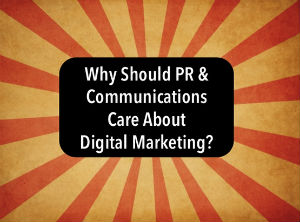 | Today I’m giving a keynote at the sold-out Communicator’s Conference in Portland, Oregon to 270 or so PR and Communications professionals.
The colliding or collaborating (depending on your situation) worlds of digital marketing and PR have left a lot of ambiguity about roles, goals and responsibilities between these 2 very important groups.
In this presentation I outline why PR should care about marketing, 3 big trends to watch for and 3 of the most common questions brand PR and corporate communicators have (I polled my LinkedIn network) about integrating PR and marketing. I finish things off with a plan for how PR and communications can tap into digital marketing expertise and contribute messaging and storytelling for more meaningful and impactful marketing / PR performance.
Here’s the full deck on Slideshare, which is featured on their home page.
I’d love to hear what your biggest concerns or observations are about the convergence of digital marketing and public relations roles.
Update: Portland’s NewsChannel 8 covered the conference and included me in their broadcast. Big thanks to Joe Smith for doing the interview and also to Barbara Kerr for setting it up:
|
Conversion Rate Optimization Software: Choose the Right Tools for Your Business
 | Conversion rate optimization is the marketing art of maximizing your investment in existing site traffic, through improvements and problem-solving rather than additional ad spend. At some point in any business site’s lifetime, CRO is a must; for smart marketers, it’s an ongoing process that pays dividends over and over again.
Once you’ve invested in attracting traffic to your site, whether to complete a purchase or take some other action, CRO helps ensure your visitors are engaged and converting at the greatest rate possible.
Some believe CRO happens only on-site, though attracting targeted prospects likely to convert through paid search ads, email marketing and landing pages, for example, is a critical step. Another misconception is that CRO is all about increasing the number of conversions. You like to make money, right? Optimizing for higher revenue conversions and increasing the value of each site visitor is another element of CRO that can’t be overlooked.
Of course, the larger your site and the more diverse your audience, the greater the task of optimizing for conversions becomes. Whether you’re tackling it in-house or using a consultant or agency, marketing software can help you better interpret the data available to you in order to improve your conversion rate and value per customer.
Your conversion rate optimization software solution may actually consist of a few different types of tools:
A/B, Multivariate Testing & Landing Page Optimization Software
Optimizely and Visual Website Optimizer are two examples of split-testing and multivariate testing software with a simple UI and no coding knowledge required. These are typically as easy to add to your site as Google Analytics code. You don’t need to actually create two (or more) versions of a page and run them against one another; your testing software will render a variation of your page in the user’s browser – there’s no IT involvement required. Visual Website Optimizer has a range of additional features including usability testing, revenue tracking and behavioral targeting, as well.
Geo and behavioral targeting can offer deeper insight into your customers’ journey to conversion. Image source.
- Ease of use. Look for a WYSIWYG interface, custom reporting against goals metrics, and code view if you’re more advanced.
- Conversion goals setting and tracking. Find a solution that allows you to establish and track multiple goals.
- Ability to test multiple pages at a time.
- Segmentation and personalization. You may want to test changes that would affect all site users, or only a select group.
- Integration with your analytics, lead capture, or other software.
Important: test your testing software. It only takes a few minutes and can save you a big headache with a new solution. Run an A/A test before you try any A/B or MVT tests. Think of this as calibrating the testing software you’re trying, except you can’t actually fix it (but you’ll know to move on if it’s not working for you!). Run your own page against itself. There shouldn’t be wild variations in conversion rates. If there are major differences, your testing software choice may not give you the most reliable insights.
You might find a testing software with landing page optimization functionality, or your needs might dictate you seek out another option. You might need a solution that integrates with Salesforce for lead capture, for example. Unbounce is worth looking into, with its landing page building, publishing, optimizing and testing features. If you’re already using WordPress, Premise is a plugin that offers the same functionality with simple set up and WP integration.
Site Analytics
In order to even begin optimizing your on-site experience for visitors, you need to understand how your presence on multiple channels affects and influences their purchasing behavior. Multi-channel funnels in Google Analytics allow marketers to see how site visitors research, compare, socialize, consider and make buying decisions across platforms.
Marketers get deep insight into assisted conversions, time lags, path length, and top conversion paths over the previous 30 days before conversion. It will take time to set up funnels for every page on your site, but this will allow you to see where, when and why people are leaving.
Social Advertising & Analytics
I wanted to mention this one specifically because social media is still written off too often as fluffy or lacking a definitive ROI. There is absolutely a wealth of information available from your social traffic and the ways you can use it for CRO vary. Take Facebook Check-Ins for a combination real-world and online retailer, for example. An offer of 10% off if you present your Facebook Check-In at the case register gives you the opportunity to know the exact order value for that social to in-store converting customer. Organic social analytics can also help you understand where your social users may be in the funnel, based on their engagement, questions and interactions.
Social advertising options, particularly Facebook, LinkedIn and Twitter Ads, have improved by leaps and bounds in the past 18 months. The targeting is far more granular and advertisers have a great deal of control over their campaigns on the self-serve platforms. Optimizing your PPC and social ads is critical in ensuring the people you are driving to your site are even going to be prospects for conversion.
In a recent blog post, Bryan Eisenberg reminds marketers to approach social landing page optimization with two important considerations in mind: Who are you and what do you do? Social media traffic is fundamentally different than search traffic, he says; social media landing pages must be thought of differently than search landing pages. However, ad and landing page best practices still apply: ads must be relevant, valuable and have a call to action, with landing pages that adhere to Eisenberg’s 10 point Anatomy of a Landing Page guidelines.
Try Before You Buy and Test, Test, Test
Did you notice we never talked about price? Remember that conversion rate optimization is one discipline in a holistic, balanced online marketing strategy. It’s not the be all that ends all and it’s not going to be your only investment this year. Some tools are free and most are quite reasonable, so if you find yourself quoted a sizable price for CRO software, seriously consider other options. Try out a few different CRO tools and test, test, test before you buy.
Many software providers also provide managed services for an additional fee. However, you may be better served by your agency or in-house team, who aren’t married to one tool and will switch if it would be beneficial for you.
Do you have a favorite solution? Share yours in the comments.
Top image from Shutterstock.
|
What Should Lead Your Online Marketing Strategy: SEO or Content Marketing?
 | There are quite a few studies showing that companies publishing more blog posts and more content in general equates to generating more business than those that don’t.
I suppose if you’re starting from scratch, adding any kind of content has the potential to improve a company’s ability to attract people seeking to buy. Since content creation is one of the biggest obstacles to companies realizing gains with content marketing, it’s no wonder that advice about how to produce articles, blog posts, infographics, white papers, and visual marketing has become so popular.
Which brings me to the point of this post. When looking for help with content marketing and content creation, there’s a difference between what one gets from a SEO agency and a content marketing agency. That difference is not so much about one being better than the other, but more about sizing up which is most appropriate for your situation.
In fact, it would be nonsensical to limit one’s options to just SEO and content marketing, so keep in mind this post is intentionally narrowly focused.
Many pure SEO agencies have added content marketing to their mix of services in the past year if not completely re-inventing themselves that way. This is the nature of SEO, adapting to the changing nature of the industry to provide current services for improved online marketing performance.
Starting as a Public Relations firm in 2001, TopRank has been in the content creation business (messaging strategy, press releases, case studies, newsletters, white papers, email marketing, etc) for a very long time. As we evolved into more of a digital marketing agency, those PR centric content efforts evolved into blogging, social media content, ebooks, infographics, video and other visual content. But we don’t create a diverse array of content types simply because we can. We create them when it’s the right thing to do for a certain audience to affect a particular outcome.
Therein lies the fundamental difference between today’s SEO focused content and what content marketers offer.
SEO is accountable to metrics like search visibility, organic search traffic and any measurable actions that lead to and result in conversions. The more content that can serve as a “hook in the water” of search results, the more the SEO can show an impact on the investment.
As I’ve been saying lately, SEO anticipates demand through an understanding of keyword popularity and content marketing creates demand driven by producing content based on the customer journey. Optimization is an effort to improve search visibility of existing content and digital assets as well as the creation of new content according to a target list of keywords.
Content Marketing is an approach that emphasizes the thoughtful creation of content for a particular audience designed to influence an action or outcome. Rather than keyword popularity driving content creation, an effort is made to understand the customer buying journey and to architect a content plan that provides the right kind of information and experiences along the buying cycle.
When a marketing strategy calls for demand creation, a content marketing strategy will provide for a holistic approach to content where ever the there’s an opportunity for customers to interact with it. That might mean online to offline as well as an intersection with other tactics like advertising, email marketing, rich media and certainly social media.
SEO is a critical partner to content marketing. Search represents a substantial opportunity for information discovery at a time when customers are actively looking for a solution. SEO plays an essential role for information discovery across the spectrum of customer lifecycle content. SEO assumes the buyer is firm in what they are looking for and that is not always the case.
Many companies are making a transition of sorts, from SEO and a focus on creating “more” content to a content marketing focused strategy that emphasizes targeted content mapped to stages of the buying cycle. Such a shift should consider a number of factors from the resources and culture of the marketing organization to a short vs. long term view towards online marketing.
Many SEO agencies have added content marketing to their mix and can provide resources for optimized content creation. The most common form is to evangelize creation of more content. As SEOs mature in their use of content, audience targeting, content planning across channels and integration with other types of content that have nothing to do with explicit search behaviors will emerge. For now, that evolution is not as common as the evangelism of “more as better”.
When a company is in need of a strategic approach, a content marketing agency will be able to help define audience segments, map buying cycles and develop a content plan that provides for storytelling that is optimized for discovery, experience and outcomes – across the customer journey from awareness to purchase to advocacy.
When it comes to SEO and content, how do you lead your online marketing efforts? Do SEO and keywords drive your content creation or do you plan content according to stages of tbe customer buying cycle? Do you define content marketing as creating more content or have you created a content strategy?
Image source: Shutterstock
|
Online Marketing News: New LinkedIn & Instagram Features, Brands Missing the Boat on Pinterest
 |
LinkedIn Adds Rich Media Capability to Profiles
LinkedIn users can now add rich media content objects to their profiles, allowing designers, analysts, authors and others to share their best works in a visually interesting format. Users can now use videos, images and presentations to demonstrate their experience. Danielle Restivo, Head of Global Programs, Corporate Communications at LinkedIn, reminds us that brands have had rich media access on their pages for some time. “The ability to share rich media through company pages is already available for admins of the Company Page. So an employee of a company who has admin rights to update the Company Page can do this, but employees without admin rights could not,” she told TopRank.
There are 15 accepted file formats for rich media on Company Pages including images, video and presentation on company pages. Restivo recommends that brands use rich media within status updates and post images and video on their Products or Careers page. Administrators can add rich media content from the “Share an update” box on their brand page by clicking the paper clip icon and adding their file. See LinkedIn’s rich media for company pages resource for a complete list of accepted file types.
Instagram Adds Tagging with Privacy Controls
Brands have a new Instagram feature to get excited about: users can now tag accounts in their image uploads, including business accounts.
In an announcement this week, Instagram explained the new privacy controls that come with this feature: “Only you can add people to your photos, so you have control over the images you share… When someone adds you to a photo, you'll receive a notification and the photo will appear in your Photos of You. Want to make sure you like the photo first? No problem: you can easily adjust your settings so nothing appears on your profile until you approve it.” Users have until May 16th to experiment with photo tagging before their Photos of You section will be visible to other users.
Automotive, Fashion Retail and Other Brands Missing Out on the Pinterest Opportunity
Fashion retail and automotive are falling down when it comes to Pinterest; according to a recent Digitas/Curalate study, 70% of engagement on brand content is generated by users rather than the brands themselves. This is especially prevalent in the fashion retail industry, where brands pin just 18% of content. The remaining 82% comes from their community repinning content.
In the automotive industry, 75% of the conversation and engagement is driven by the community, with just 25% of content originating from brands. “It’s unfortunate to see the auto industry stuck in first gear. The industry needs to leverage the heritage of their brands to tell compelling visual stories that create emotional connections with consumers,” says Apu Gupta, CEO of Curalate. He added, “While automotive websites may not discard Flash anytime soon, some straightforward changes make these sites shareable, now."
"Brands need to go forth and pin," says Jordan Bitterman, Senior Vice President, Social, Mobile and Content Lead, Digitas. "This study reveals the opportunity for brands to drive the conversation on visual platforms like Pinterest. By leveraging rich consumer insight, brands can take the guess-work out of their visual content strategy, and share the types of images their audience wants to see."
Google Adds Real-Time Conversion Reporting
With the latest Google Analytics update, marketers can now see how many of their site visitors are converting and against which goals. Clicking on a specific goal will automatically segment that report, allowing marketers to track the performance of new campaigns in email, PPC, or TV, for example. An important caveat from Google: “…with this first launch we're introducing URL based goals only. So computed goals such as Time on Site or Pages/Visit are not included yet.”
Oxygen and Tumblr Move to Further Integrate Television and Social Media
Beginning May 8th, TV network Oxygen will begin airing the best animated GIFs from Tumblr, in an effort to further integrate the television and social experience for audiences. ”When it comes to reality TV, it’s really astounding to see just how much people like making animated GIFs for our programming,” senior vice president of digital at Oxygen Media Harleen Kahlon told ClickZ.
Twitter Opens the Door to All US Advertisers
Over a year after launching their self-serve ad platform, Twitter announced this week they’ve ended the invite-only period and opened the door to all advertisers in the United States. “Over the past year we've listened carefully to feedback from the thousands of businesses and individuals who've had access to the self-serve tool, and made enhancements based on their suggestions, including more targeting and reporting in the UI,” wrote Ravi Narasimhan, Product Manager in Revenue at Twitter. Marketers interested in using Twitter for social advertising can get started immediately at business.twitter.com.
This Week in the @TopRank Community
This week, Online Marketing Blog welcomed the 25,000th member of our Facebook community into the fray!
Community members across all of our networks got access to the full video from Lee Odden’s Future of Content presentation at MIMA this past week. Odden explored the true meaning of content and how content teams are structured (and should be structured) in organizations, then shared upcoming trends marketers need to watch for. See the full presentation:
Next week, join us on the @TopRank Twitter channel May 7th, as Lee Odden presents Optimize 360: An Integrated Approach to Digital Marketing and PR in a PRSA webinar. On May 8th, tune in for live tweets at 12:15pm from Communicator’s Conference, where Odden will share his keynote address, Digital Convergence – The Integration of Marketing & PR.
|
3 Ways to Use Multi-Channel Analytics Reporting for Better Marketing & Business Decisions
 | The average consumer goes through more than five touch points with an ecommerce business before they convert. This number is trending upward, as companies and customers continue to interact across a greater number of platforms. B2B companies, with often greater price points and a longer buying cycle, may find the number of interactions with prospects prior to conversion even higher.
Good content marketers know that integrated, consistent messaging is critical across multiple digital platforms. It allows us to connect with our customers how – and when – they expect to connect with us.
With so many touch points between first contact and conversion, how are companies able to break through all of the data within analytics? We need to determine not only which channels are most effective, but also how to customize marketing activities to the behavior and preferences of the audience in that channel, at that point in their decision.
For example, a TopRank ecommerce client recently lamented the portion of conversions that could be attributed to direct search or branded search. According to their interpretation of the data available to them, the majority of their conversions came from direct traffic. Why then, they asked, are we dedicating resources to social media and SEO when their only purpose seems to be building brand awareness?
It’s a valid question; companies can’t afford to sink budget into underperforming channels or tactics. However, a deep dive into their Google Analytics data showed us that:
- 75% of conversions are assisted (or included multiple digital touch points).
- About 50% of conversions can be attributed directly to organic traffic.
- 80% of conversion paths included organic search as a touch point.
In fact, their second most popular conversion path looked like this:
Arrives via Organic search (usually non-branded) > User leaves the site (probably to shop around) > User Returns via Direct Visit
For this particular client, SEO is absolutely a critical part of their mix! It would have been a grave mistake to discount search optimization altogether. In the mobile & social age, businesses must use Analytics data from multi-channel conversions to shape their marketing mix, as this ecommerce client did. That deeper understanding of your customers and prospects will help you make business decisions that make sense, founded in the most recent, relevant data available.
Let’s explore 3 ways to use multi-channel analytics data to shape your marketing strategy.
#1: Review social as part of assisted conversion strategy
Tracking ROI on social can be tricky; for many businesses, it's less likely to be considered a referring source and more likely to be used as a means for amplifying content or interacting with customers and prospects directly. However, reviewing social as part of your multi-channel funnel will give you a much better idea of how your social visitors are interacting on the site.
To illustrate this, we’ll use the real-world example of relatively new fashion brand and TopRank client, who boasted higher-than-average traffic from social networks. Based on their analytics, we knew social traffic only contributed to 15% of total visits, yet the average social visitor spent 4x as long on the site and visited more pages.
Social as last click represented only a small portion of converting visitors, but social actually contributed to well over 30% of transactions. We knew for this business, social visitors were more apt to buy than the average user. Additional sales-oriented content to their social audience helped their social fans feel more valued and connected to the brand.
The takeaway: Consider conversions beyond a purchase or Contact Us and you may find social visitors are more likely to download a white paper or watch a video than the average user. This information not only can help you refine your marketing mix, it can also shape your content plan by indicating the action your social visitors are most apt to take.
#2 Customize Multi-Channel Reporting
Organic search, direct and referral sources are automatically detected by multi-channel reporting. Going above and beyond to track emails campaigns, PPC, and branded vs. non-branded keyword traffic requires some additional setup, but is well worth your time.
For example, distinguishing between branded and non-branded keyword traffic is a must for businesses measuring the impact of their SEO efforts. In our first example, an ecommerce client believed all conversions were coming from direct and branded search. However, filtering branded versus non-branded traffic allowed the client to not only see the impact of organic search as a whole, but also how non-branded searches were often the first touch leading to subsequent branded searches or direct visits.
The takeaway: Create a custom channel grouping leveraging unique labels for platforms. In addition to rounding out your marketing mix, customized grouping will allow you to mine out more data from the detected channels.
#3 Integrate for Advanced Attribution Modeling
The free version of Google Analytics is only going to track multichannel conversions over the course of 30 days. This is great for businesses with shorter buying cycles, but can prove problematic for products or services with a buying cycle longer than 1 month.
For businesses with longer buying cycles, or those looking to do more advanced attribution modeling, passing an anonymous Visitor ID along to the user to track behavior via integration with a CRM or Marketing Automation platform is key.
The takeaway: Don't remove Social Media or display ads from your marketing mix just because you don't see those sources converting is your multi-channel report. Instead, integrate with your CRM or marketing automation software for a complete picture. It's likely those touch points are still contributing to increased awareness in earlier stages of the buying cycle.
As marketing mixes become more complex, data grows, and we push more toward integrated marketing, it can be challenging to connect performance to specific tactics. It’s now more important than ever, though. Customizing and diving into multi-channel conversion report is a great step toward increasing your brand’s awareness of your greatest performers and potential. Without this clarity and accurate insight, business decisions are really only best guesses based on faulty logic.
Is your business already using multi-channel reporting or more advanced attribution modeling? Share your thoughts in the comments.
Image at top from Shutterstock.com.
|
Creative Content Marketing Strategy from Brands Killing It with Content
 | Content marketing has exploded over the past year and will continue to grow in importance throughout 2013. Still, many marketers make the mistake of rushing to publish or producing content without a purpose in an effort to capitalize on the trend.
Quality rules the day when it comes to content creation. We write often here on the importance of content planning and optimization and Lee Odden offered a complete framework for optimizing across SEO, social media and content marketing in his book, Optimize.
Here are just a few examples of brands killing it with great content. Check them out and see what lessons you can take away to improve your own content strategy:
Open University Excels in Multimedia Content Creation
In April 2012, OU became the first European university to reach more than one million subscriptions on their iTunes channel, which has seen approximately 62 million content downloads. They also have the distinction of being the first UK university with a YouTube channel. To date, they’ve had over 12 million views on their main channel, with over 45,000 subscribers.
Open University are succeeding through the creation and distribution of optimized content by addressing the needs of their audience with a variety of content formats. Video is a natural solution for illustrating concepts or demonstrating processes, both important teaching methods.
Their move to podcasting was incredibly savvy, as it allowed them to reach students (both potential and existing) in a format they could take with them and listen to across devices, on the go. Social content optimization has also helped them build a network of 96,000 fans on Facebook and over 59,000 followers on Twitter.
Corning Complements Video with Repurposed Written & Visual Content
Corning’s A Day Made of Glass video was a hands-down viral success, with over 21 million video views and an incredibly successful sequel.
Corning launched the video at their annual Investor Day in New York, Feb. 4, 2011. By late April it had logged 12 million views on YouTube, BtoB reported. In addition to the video, their team created a page on their corporate website for frequently asked questions about the video, creating complementary written content in the process. They also created a series of images fans could share across social networks and issued press releases around the launches.
A Day Made of Glass was meant as a conversation starter with product design and R&D organizations. That it became a social success among consumers, as well, is a testament to Corning’s creative content marketing skills.
SAP Taps Into Audience Emotions with Love vs Hate Content
SAP are killing their content strategy across their social channels with innovative campaigns like Love Hate Data, which included a microsite, infographics, blogs for both the data haters and the lovers, as well as Twitter accounts @datalovers or @datahaters.
This particular campaign was created to promote SAP’s entry-level business intelligence tool, Crystal Solutions. Web content was designed to elicit an emotional, powerful response from their audience and target market by allowing them to identify with either one of two personas: the data lover or the hater.
A December 2012 case study reveals SAP was able to start over 700 online conversations and generate 580,902 tweet impressions through this creative campaign.
Three Steps to Creative Content Marketing Success
Successful creative content marketing strategies have three distinct considerations, as Lee has often pointed out:
Discovery – Businesses understand how does their audience finds content.
Consumption – Brands optimize for an experience that resonates with their audience.
Action – Companies inspire their audience to take action, effectively converting social fans and prospects to buyers.
The brands featured in this post are successfully transitioning to the role of publisher, with top quality, interesting content that has helped them build communities and influence their audience. What steps have you taken to move to a publisher mentality?
Image at top from Shutterstock.com.
|
Do Advertorials & Native Advertising Fit In Your Content Marketing Strategy?
 | Where do advertorials, also know in politically correct terms as “native advertising”, fit into the content marketing toolkit? To answer this question, we first have to understand what advertorials are – and also that the definition of content marketing itself is a hotly contested topic.
Adam Stetzer of HubShout, in his recent investigation into the purported Google penalization of Interflora for employing advertorial content, insists advertorials are NOT content marketing.
“Advertorials are advertisements, regardless of how you try to dress them up”, he says, “while content marketing is educational. Advertorials are biased; content marketing is free of any bias. The two may share a commercial motive, but are completely different and should be treated as separate entities”.
However, Lewis DVorkin, Chief Product Officer at Forbes Media, defines content marketing as "Brands using the tools of digital media and social sharing to behave like original-content publishers."
His definition of content marketing includes AdVoice, the Forbes service he was speaking of at the time. "First launched 20 months ago, it's a fully transparent way for marketers to publish and curate content on Forbes.com and in our magazine." In fact, Lee Odden was included (unbeknownst to him) in a recent Forbes AdVoice article published by CapitalOne, “Use Content Marketing to Boost Your Business” which looks and reads pretty much the same as regular Forbes content.
It seems, then, that DVorkin's vision of content marketing is not restricted to the unbiased, but that advertorial content is acceptable where parties ensure transparency for readers. "Content is content," he says, "and transparency makes it possible for many different credible sources to provide useful information."
Are Advertorials Evil By Their Very Nature?
Marketers like John Bethune at B2BMemes take exception with DVorkin's definition. In a post questioning this expansion of content beyond owned into paid, he asks, "When a publication buys content (from staff writers or contributors), that clearly counts as editorial. But when the publication is paid to publish it (by advertisers), is it still editorial?"
It's a valid question.
Advertorials have been around since the 1940s, when savvy newspaper publishers realized the potential of ad content posing as editorial. Then came infomercials, those wonderful paid programming spots that helped networks fill the dead air and increase their off-time revenue.
Fast forward to the modern web; advertorials might also be known as native advertising, or more commonly, sponsored content. They typically appear in blogs as well as print and online magazines and newspapers. Sponsored content allows brands to reach beyond their own audiences, to inform, engage and convert readers through content that (ideally) reads as editorial despite the underlying advertising message.
This advertorial ran in local newspapers through a service called Universal Media Syndicate. Though clearly marked an advertisement, it has a definite editorial look and feel.
Google itself has pushed the envelope as far as clearly indicating which of their content is organic or paid and has had many conversations with the FTC as a result. So while some have rightly questioned whether Google's stance on advertorials is a move designed to cut their paid advertising competitors off at the knees, it doesn't seem so. The penalization of flower brand Interflora for participating in BBC advertorials seems a natural extension of their paid links policy. As Stetzer points out in his evaluation of the situation, penalization for advertorial content can be prevented/remedied by ensuring all links in the content are no-follow and do not pass PageRank.
Still, we have the ethical question: do advertorials have a place in your strategy as one of the content marketing tactics to consider?
Are Advertorials Even Content Marketing At All?
When Lee Odden recently asked his social network of marketers to share their definitions of content, the range of answers was surprising:
- Information designed for consumption, seasoned for enjoyment, and packaged to share.
- Content comes in any form (audio, text, video), and it informs, entertains, enlightens, or teaches people who consume it.
- Content is high quality, useful information that conveys a story presented in a contextually relevant manner with the goal of soliciting an emotion or engagement.
- Relevant, compelling, timely and valued knowledge and/or entertainment.
- Original and opinion-charged copy with a focused message and personalized voice.
In fact, after perusing the 40+ definitions of content, I don't see anything about paid content falling within the bounds of content marketing territory. Then again, I see nothing definitively excluding it as a viable tactic, either.
When Advertorials Are Okay:
Unfortunately, many online marketing tactics that show promise are milked to death and taken way too far by overzealous marketers. Instead of an outright ban on advertorial content, maybe what we need is a set of common sense, ethical guidelines for its use.
“With today’s savvy consumers, sponsored content, native advertising and advertorial isn’t effective unless it provides valuable and useful information,” TopRank CEO Lee Odden recently told a German business magazine. “With reputable publications, similar, if not the same, editorial standards apply as they do for pure editorial content. The only difference is the means of inclusion: payment or editorial.”
With that in mind, here are some common sense guidelines for advertorial, native advertising or sponsored content:
- Top quality – never forget the "editorial" part of the equation. Your competitors may have former journalists and professional editors at their disposal, as should your brand.
- Avoid overtly promotional language because it's ineffective and makes you look silly.
- Aim to inform, educate, and/or entertain readers, as with other types of unpaid content.
- Offer transparency and does not attempt to trick readers into believing they are reading unbiased, journalistic content.
- Use no-follow links to avoid passing PageRank and falling outside Google's guidelines.
- Serves its purpose through careful planning and alignment with your business goals.
- An accurate reflection of your brand voice, company culture and capabilities.
Advertorial content has been a sticky topic lately, although it doesn't have to be dismissed without consideration. If sponsored content makes sense as a marketing tactic for your company and you can find an opportunity for placement with a reputable publication and measurable ROI, it may be worth considering. Just remember that content, whether it’s published purely based on editorial merits or as part of an advertising program, isn’t effective unless it creates value for the reader.
Are you using advertorial content as part of your marketing strategy? Share your tips or thoughts on the practice in the comments.
|
The Best Marketing Investment You'll Ever Make
 | Inbound, content, social, mobile, converged, omni-channel, transmedia. The list of marketing channels and strategies vying for our budgetary attention goes on and on.
Where should companies invest to attract more attention and engage those that would influence or act on buying?
To answer that question, we could consider the promotional advantages of each discipline:
- Inbound Marketing – Inbound drives 54% more leads than outbound (HubSpot)
- Content Marketing - 61% of consumers say they feel better about a company that delivers custom content and they are more likely to buy because of that (Custom Content Council)
- Social Media – 74% of consumers rely on social networks to guide purchase decisions (Salesforce Marketing Cloud)
- Mobile - 41% of smartphone owners have made a purchase from their mobile phones & US m-commerce sales will reach $31 billion by 2015 (Visual.ly infographic)
- Email Marketing - Email generates $39.40 for every dollar spent (DMA).
But of course there are advantages to each. The problem is that they are not universally applicable or true. So you might ask, what is universally true? What thing can we invest in as businesses for the greatest return on marketing spend? In my opinion, it’s this:
The best investment you can make in marketing is the quality and experience of your “product”.
Whether you sell a tangible thing or a service, your “product” provides an experience and consumers are more empowered to share the stories of those experiences now than ever before.
Consistently delivering a great experience amongst a community of customers empowered to create, consume, publish, interact and transact any where, any time inspires the most scalable and powerful “sales force” you could ever hope to advocate for your brand.
Just look at services like Uber that have forgone most traditional advertising and marketing and simply created a service that’s so useful that people are compelled to talk about it. They tell stories about their experience.
“Talking about it” in today’s digital world means creating and sharing content on the social web where a single positive moment can be shared and reach hundreds or thousands of people. Add up hundreds or more of those moments on a daily basis and you can see how those stories can spread.
A big part of what contributes to customer experience with products and services outside of the fact that they “deliver on the promise”, is how stories are discovered, where and how they are consumed and the means by which they are shared and acted on.
Yes, that means beyond creating a fantastic product (fantastic is defined by buyers) where there is some opportunity and necessity to optimize the discovery, consumption and actions taken as a result of those stories. This is the promise most of the marketing channels and tactics I mentioned above make.
The effectiveness of any of those channels depends on the quality of the product experience and the meaningful stories that surround it. That means stories communicated, curated and promoted by the brand as well as the people who experience the product.
While you certainly know intuitively, the value of product or service quality, do you see it as a marketing investment? How does product or service quality and experience factor in to your marketing? What are the key stories about that experience being told through brand and by customers?
|
Online Marketing News: Predictive Social Tools, Content Marketing & The Customer Journey
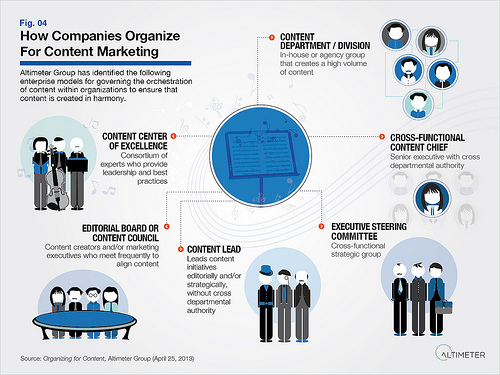 | Brands understand the importance of content marketing, yet most have not yet addressed their content needs on either a strategic or tactical level, according to Altimeter’s Rebecca Lieb.
Researchers for the company conducted interviews with executives actively engaged in content strategy or marketing; their findings were the basis of a new report, Organizing for Content: Models to Incorporate Content Strategy and Content Marketing in the Enterprise. Lieb and report co-authors guide brand marketers through a variety of organizational models for content, with recommendations to help companies execute an effective content strategy. Read the full report on SlideShare.
Trust Can Make or Break the B2B Buyer Relationship: Study
Buyers are overwhelmed by the amount of content available to them, making the content marketer’s challenge greater than ever, according to a new study from Demand Gen Report. Content plays an increasingly important role in B2B purchase decision making, with 68% of survey respondents indicating they rely more on content than they did last year. Variety is key: five out of nine content formats gained in popularity, while only podcasts and interactive presentations lost traction. Researchers found that three specific content formats stand out in 2013: white papers, E-books and webinars.
Sales messages are a huge turnoff for buyers, 61% of whom said sales-heavy content has been a problem for them in the past year. Survey respondents indicated they would like B2B marketers to focus on making content more readable, adding value, and showing their research to their audience.
Google Launches Interactive Customer Path to Purchase Tool
The customer journey is complex, with engagement happening across platforms, devices and possible over a period of time, says Google. Their new tool on the Think Insights website aims to help marketers “explore and understand the customer journey to improve your marketing programs.”
Users can toggle through different industries and countries including the US, Canada, Brazil, UK and Germany in order to see whether channels tend to play an “assist” or “last interaction” role in the typical path to purchase. The length of the customer journey can impact purchase value; Google’s tool also allows marketers to explore combinations of number of days or steps to purchase, industries and countries, with their resultant effect on average order value. In the example above, Google shows that 66% of total US retail revenue comes from purchases made in more than one step. Their findings are based on Google Analytics data and should offer valuable macro-level insight for marketers.
Bing Research Shows Over 50% of Users Click on the First Results on the SERP
The majority of searchers click on the first link available on a search engine results page, with a dramatic reduction in clicks for each position thereafter, according to Dr. Ronny Kohavi from Bing’s Research & Development team. By the time you reach the 8th link on a results page, less than 1% of users will choose it, as shown below.
Dr. Kohavi explained in the announcement of their findings, “The figure (above) shows the click-through rate dropping from position 3 on, where position 3 could contain an Instant Answer, or the 2nd web result that was pushed down because there was an Instant Answer above it, etc.”
Expect more changes in the near future. “These are our first steps in dynamically sizing the page,” Kohavi wrote. “ If you're getting different number of results, you're probably in one of our ongoing experiments.”
Goodbye, Google Instant Previews
If you noticed that Instant Previews are now absent from Google search results, you’re not alone. Search Engine Land went on a quest to find out what had happened to the feature Google promised on its launch it 2010 would result in greater user satisfaction. After confirming Instant Previews are indeed gone, SEL found an online help thread with a statement from a Googler reading, “Instant previews saw very low usage by our users, and we've decided to focus on streamlining the page to benefit more users.”
New Social Platforms Venture Beyond Real-Time Marketing to Predictive?
Two major players and a startup all released new social platforms this month. ClickZ’s Susan Kuchinskas shares details on Social.com, the new offering from Salesforce, and Adobe’s Predictive Publishing for Facebook dashboard plug-in.
It gets really interesting with startup Blab, launched April 9. “We don’t do projections, we do predictions based on the pattern and behavior of the actual conversation,” Tamsen Galloway, vice president of Blab, told Kuchinskas. “We can see where a conversation will be in 24 hours, and how that may change between 48 and 72 hours later.”
Blab uses a “conversation canvas,” as shown above, for each brand interest or goal, ie.: brand mentions, competitor mentions, news around events or topic, etc. Kuchinskas explains, “The platform applies its patented predictive and analytic technologies to data streams from social channels and the web, analyzing some 1.3 terabytes of data at any moment.” This gives brands a unique opportunity to actually get ahead of conversations, with time to craft messaging and content in anticipation of opportunities.
This Week in the @TopRank Community
Members of the @TopRank social community tuned in for TopRank CEO Lee Odden’s content marketing presentation at Content2Conversion this week in New York. Attendees shared livetweets, photos and even a cool takeaways Vine on Twitter throughout the event.
Over in the TopRank Facebook community, 10 fans will each win a copy of Lee Odden’s Optimize: How to Attract and Engage More Customers by Integrating SEO, Social Media and Content Marketing as we reach a milestone with 25,000 members in our community. Stop by and check it out; page comments get preference!
Check out the @toprank Twitter channel and stay tuned to #trnews for breaking news across the digital marketing landscape in the weeks ahead!
|
Brands Gone Wild: Social Media Marketing Fails & Lessons Learned
 | So you want your campaign to go viral…
Let's keep in mind your business objectives, shall we? As these social marketing fails will show, campaigns may take off but go seriously sideways if companies place popularity above purpose.
Some companies can afford more risk and racier campaigns than others, yet risk in business must always be mitigated and justifiable based on the potential rewards. You might disagree with my opinion on the campaigns featured in this post, but I believe the risks should have been evident from the start and far outweighed the potential payoff.
These examples may cause you to shake your head, or enjoy a good belly laugh, but each is a fantastic learning opportunity for social media marketers.
Money Can’t Buy You Love – nor Common Sense
We'll kick off with KFC's #IatetheBones. Fried chicken execs are literally throwing everything they've got at their viral tagline, which they expect to be the next "Where's the Beef?" Launched April 14th, the campaign has invested in it an estimated $50 million budget, Interpublic's DraftFCB agency and an Academy Award winning director for the ads. Considering this tagline is to take them boldly into their new position as a boneless chicken brand, the budget and scope are not all that surprising.
Why, then, did no one stop to consider the potential negative effects of associating a food brand with sexual innuendo and dead bodies? Worse still, did they consider it and decide it was worth rolling the dice? When you read the user-generated content on #IatetheBones, that a food brand would approve of the association puts KFC squarely in Quizno's horrendous "2 Girls, 1 Sub" space.
As I'm writing this, one sentiment analysis tool puts the amount of positive buzz around #IatetheBones at just 51%. Compare that to 80% positive sentiment for the @kfc brand itself on Twitter. The hashtag sentiment analysis came from a sample of 50 tweets, so I tried another tool to compare, which analyzed in real-time and came up with 74% negativity around the #IatetheBones hashtag.
Apparently the hashtag did well in test markets and inspired people to go online and share videos and comments. Unfortunately, people are sharing memes of people choking on chicken bones, or Hannibal Lecter:
They're resurfacing years-old animal rights videos and tagging them with #IatetheBones, making those videos appear in social search again with this new campaign. They're blindly tweeting on the hashtag with no message at all, trying to make it trend. Is this convincing anyone to go buy boneless or think better of the brand? Probably not when they're sharing tweets about how much fun they're having with their chicken and dead girls:
Did no one on the entire team it took to put all of this together realize or even care that "bone" invites all kinds of not-even-subtle phallic and cannibalistic commentary?
"Where's the Beef?" worked because it's catchy, cute and relatable. Everyone has a beef at some point. We're not all going to eat the bones. Ya dig?
Then, I could be completely wrong. Maybe this one really will take off and KFC will have ushered in a new pop culture catchphrase as the result of their clever marketing. I still think it seems far more likely the conversation is going to continue its downward spiral, finally crashing and burning at the precise point that reading the tweets on #IatetheBones would make Tommy Lee blush.
If You Want to Gamble on User-Generated Content, At Least Be Sure Customers Like You
Moving right along, another memorable social campaign fail also came from a fast food giant – THE fast food giant – by way of #McDStories. McDonalds' campaign kicked off innocently enough, with two tweets sharing stories about their employees, food and suppliers.
The problem with viral marketing is that it takes users generating and sharing content to make it popular. As McDonald's learned, you just never know what people are going to share. #McDStories tweets told tales of everything from throwing up Happy Meals to animal abuse to things I can't even type as they make me a bit queasy.
Is that good branding? Is the gamble on a viral tagline worth potentially damaging your brand to the point people are still talking about the episode over a year later? I'm guessing in McDonald's case, their sales didn't suffer too terribly, though you have to wonder if their investment was money well spent. McDonald's later admitted that "#mcdstories did not go as planned." Fail.
A Reputation Takes Years to Build and One Stupid Social Campaign to Destroy
Next up:
Yes, friends, this actually happened. Some social media rocket scientist thought this was a good thing to post to Belvedere's Facebook and Twitter pages. Do I even need to elaborate? No, the portrayal of a rape scene is not a good endorsement for your alcoholic beverage. Spokespeople for the company were sorry. Unfortunately, this was so ill-conceived – and there were so many stops along the way someone should have thrown up a roadblock – that no one really cared how sorry they were.
Other dishonorable mentions for social media campaigns that should never have seemed a good idea, even at the time, go to:
- American Apparel for their completely classless Hurricane Sandy sale.
- Microsoft for asking Windows Phone Twitter followers to share horror stories about Android phones on the hashtag #DroidRage. Followers virtually ripped off Microsoft's arms and verbally beat them with the stumps, leaving a bloody trail of Windows jabs in their wake.
- Kia for attempting to ride the coattails of the popular Cheezburger brand with a meme campaign that had one user tell the auto brand to "Get off of the internet."
The moral of the story, marketers, is that you can probably pull off something wildly popular and crazy and risqué if you try hard enough and throw enough money at it… but do you really want to? Part of any campaign worth its salt is a critical evaluation of each element and any potential risks. Are those risks manageable? Is it really worth the risk when you can’t control your social audience?
Plan to Succeed and Never Appear in a Fail Blog
First, consider the purpose of your social marketing strategy. You may be trying to:
- gain insight into your community
- build brand visibility and authority
- influence buyers
- promote products and services
- drive traffic to your website
- increase search visibility
…or some combination thereof. Once you’ve established your goals, you’ll plan to employ specific tactics to help your brand achieve them. A social media marketing checklist like this one Lee Odden created and shared can help you get the right people and processes in place to execute your plan. As you implement, measure, and hopefully improve your social strategy, it’s important to remember your social presence is an extension of your business presence. You can’t get away with any more online than on television or radio; the same people are listening and they see everything you do online in an instant.
Whether all of your planning and social management takes place in-house or with the assistance of an agency, you must protect your brand. Work with professionals who value your reputation as much as you do. Choose agency partners that value performance, brand loyalty and measurable results over cutesy campaigns and “buzz.”
If you’re not sure, stop. Just stop. Calculated risk is one thing. Diving head first into issues you don’t understand (or have no real reason to talk about) simply because they’re popular or trending is an invitation for a social PR disaster – and we’ve seen plenty lately. Share the most memorable social fails you’ve seen in the comments!
Top image courtesy of Shutterstock.
|
In Search of Voodoo: Optimizing the Customer Journey on the Search & Social Web
 | I get to meet a lot of professionals in the marketing, advertising, communications and public relations industries where topics of conversation often revolve around content. Concerns about where to start, what tactics work best, how to plan, produce and promote all come into play right along with staffing, integration with other channels and measurement.
Of course, if you try hard enough you can worry yourself out of a job when it comes to developing a solid approach with content marketing.
On the one hand, there’s a temptation to spend a lot of time and resources developing “the perfect” strategy. On the other hand, you could also just start cranking out content and see what sticks.
Neither of those approaches really work well in a practical way. What does work? There’s one thing that can help answer many of the concerns marketers have about content and that also helps you cut to the chase for practical implementation: Understanding the customer journey.
Google Think Insights has a great post with tools to help marketers better understand how different content and channels affects customers during the buying cycle or customer journey to online purchase. Check it out and then come back.
Welcome back. Google has some of the best content marketing, don’t they?
There’s a saying that goes something like, “Walk a mile in a man’s shoes to really understand where he’s been” that reflects what a lot of companies don’t consider when creating their digital marketing plans.
Understanding the customer experience from awareness to consideration to purchase folds well into the core principle of Optimize – to empathize with your customer and understand how they discover, consume and act on information. By doing so, you can create a practical digital marketing plan that optimizes for attraction, engagement and conversion.
To put that idea of customer empathy in action, I put myself in the position of a customer and documented my journey from curious social browser to a highly motivated searcher.
I started on Facebook, asking my network (as many people do) for recommendations on things to do and see in Portland. Immediatley, Melodie Tao not only made several recommendations including Powell’s Bookstore, Voodoo Doughnuts and Portland City Grill, but she pointed me to a blog post where she had documented her visit to Portland. Pretty awesome right? I received many more suggestions from other friends too.
But is that all I needed to take action? Maybe for some people. But I needed more information, especially about Voodoo Doughnuts. So what do you do when a friend recommends something and you need to get more details? Where do you go to get more facts and information as well as to validate their recommendation?
Yes, that’s right. You Google it.
Lucky for me the search results for “vodoo doughnuts” reveals a cornucopia of useful information including reviews, local information, coverage in local and national press, the business website, map, address and even photos of the product.
That was enough for me. I knew I needed to include Voodoo Doughnuts in my presentation. If for nothing else, to experience the freak of sugary gastronomy that is known as a “Bacon Maple Bar“.
Arriving at the store didn’t disappoint and of course I had to take photos. And what do you do with those photos?
You use them when you check in on Foursquare.
Then share to Instagram and Pinterest of course.
The takeaway here is to think about the ways in which your target audience discovers, consumers and acts on information so you can give them what they want. Optimizing for the customer journey means bringing in content, social media, search, advertising and even PR to help your brand become the best answer whether customers are asking their friends on Facebook or searching on Google.
It may not be practical to literally put yourself in your customers’ shoes, but maybe there’s an opportunity for a virtual “ride along” by talking to sales and business development staff or product marketing at your company. As much pressure as there is for ROI, don’t solely focus on optimizing for transactions, but optimize for experiences as well.
Is there a proactive effort at your company to map the customer journey? If you have multiple, distinct customer segments, do you identify the sales cycle for each group? What are some of your challenges and successes?
|
| |


